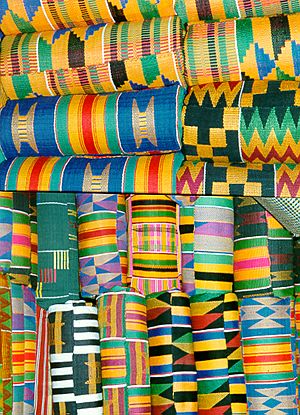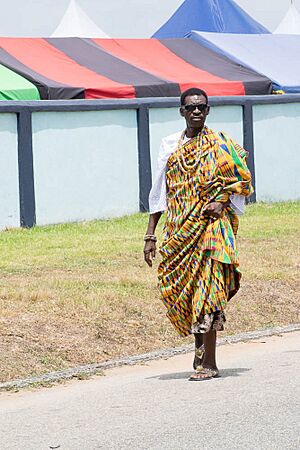Kente cloth facts for kids
Kente is a special fabric from Ghana. It is made from silk and cotton threads woven by hand. Long ago, kings and queens of the Ashanti and Akan people wore it like a fancy robe. It first came from a place called Bonwire in Ghana's Ashanti region.
Today, many people wear Kente for important celebrations. Skilled weavers create popular Kente designs. People in Togo and Ivory Coast also wear it. You can find Kente patterns on many clothes made in factories. Around the world, Kente patterns are even used on sashes worn at graduation ceremonies.

Contents
What Does "Kente" Mean?
The word 'Kente' comes from kɛntɛn. This word means "basket" in the Asante dialect of the Akan language. It describes how Kente looks like a woven basket.
The Akan people in Ghana also call it nwentoma. This simply means "woven cloth". An old Ashanti story says that weavers learned to make Kente from watching Anansi the spider. They wanted to copy the spider's beautiful web designs.
The Story of Kente Cloth
People in West Africa have been weaving fabrics for thousands of years. Very old weaving tools have been found in places like Begho and Bono Manso in Ghana. These tools are from the 14th to 18th centuries.
Ashanti stories say that Kente weaving started in Bonwire. A person from Bonwire brought a special loom to the Ashanti people. This happened during the time of King Nana Oti Akenten in the 1600s. Another story says that people in Bonwire created Kente themselves. They were inspired by the amazing web designs of a spider.
In the 1700s, King Opoku Ware I encouraged more craft work. He even set up a factory to improve weaving in the Ashanti Empire. This was the start of Kente production. People at the time described how the factory worked:
Some of his subjects were able to spin cotton, and they wove bands of it, three fingers wide. When twelve long strips were sewn together it became a "Pantjes" or sash. One strip might be white, the other one blue or sometimes the was a red among them...[Asantehene] Opoke [Ware] bought silk taffeta and materials of all colours. The artists unravelled them.
By the early 1800s, silk Kente was very well developed in Ashanti. A visitor in 1817 noted that Kente cloths were made in "all the varieties of colour, as well as pattern." They were also "of an incredible size and weight." The word "Kente" might have been given by Fante traders to the Ashanti fabrics.
The Ewe people also have their own version of Kente. It is made from double-woven bands. Ewe weaving traditions go back to the 1500s. Weavers were among the people who moved to Ghana from Benin Republic and Western Nigeria. By the 1700s, Keta became a main weaving center for Ewe people.
How Kente is Made
There are three main types of Kente cloth. First, there is authentic Kente made by traditional weavers. Second, there are Kente prints made by companies like Vlisco. Third, there are mass-produced Kente patterns, often from China. Authentic Kente is the most expensive.
The towns of Bonwire, Sakora Wonoo, Ntonso, Safo, and Adawomase are famous for Kente weaving. These towns are in the Ashanti region.
Weavers use a wooden loom. They press together many threads of dyed fabric. Weavers usually learn from a master weaver for several years. After that, they can create their own patterns. Finished rolls of cloth are often stamped with a brand. This shows that they are real and authentic.
Traditionally, Kente weaving is done by men.
Kente Patterns and Their Meanings
There are hundreds of different Kente patterns. Each pattern has a special name or message from the weaver. Ghanaians often choose Kente cloths for their names, as well as their colors and patterns.
The patterns are mostly found in the long (warp) threads. Names come from many sources. These include proverbs, historical events, important chiefs, queen mothers, and plants. Kente cloth shows high value and importance.
Ahwepan is a simple Kente design. It uses basic stripes and a single pair of heddles. Kente designs are usually abstract. But some weavers also add words, numbers, and symbols. For example, adweneasa means 'I've exhausted my skills'. This Kente is very decorated. It has patterns woven into every space. Because of its complex patterns, adweneasa needs three heddles to weave.
What Kente Colors Mean
Each color in Kente cloth has a special meaning:
- Black: Means growing up, strong spiritual energy, spirits of ancestors, and funerals.
- Blue: Represents peace, calm, and love.
- Green: Stands for plants, growth, and spiritual renewal.
- Gold: Shows royalty, wealth, high status, glory, and spiritual purity.
- Grey: Used for healing and cleansing. It is linked to ash.
- Maroon: The color of Mother Earth. It is linked to healing.
- Pink: Linked to the female side of life. It is a soft, gentle red.
- Purple: Linked to feminine parts of life. Women usually wear it.
- Red: Shows strong feelings, bloodshed, and death.
- Silver: Means calm, purity, and joy. It is linked to the moon.
- White: For cleansing, special ceremonies, and happy events.
- Yellow: Means preciousness, royalty, wealth, and beauty.




